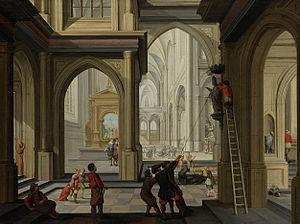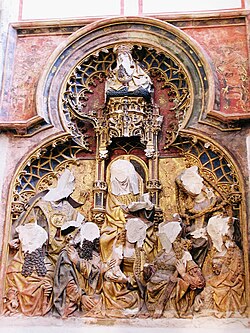طوفان شمایل
.]]

موضوع اثر به ماجرای شمایلشکنی بزرگ میپردازد.
این اثر اکنون در مالکیت موزه امپراتوری قرار دارد.

طوفان شمایل (به هلندی: Beeldenstorm) یا شمایلشکنی بزرگ اصطلاحی است که به گسترش نابودی تصاویر مذهبی در سده شانزدهم میلادی در اروپا اشاره دارد. در طول این سیل شمایلشکنی، هنر کاتولیک و بسیاری از اسباب و تزئینات کلیساها به شکل مخفیانه یا غیررسمی توسط جمعیتهای پروتستان کالوینیست که جزئی از اصلاحات پروتستانی بودند، نابود شد.[۱][۲] بیشترین تخریبها در آثار هنری کلیسا و اماکن عمومی رخ داد.[۳]
منابع
ویرایش- ↑ Marshall, Peter (22 October 2009). The Reformation (به انگلیسی). Oxford University Press. p. 114. ISBN 978-0-19-157888-5.
Iconoclastic incidents during the Calvinist 'Second Reformation' in Germany provoked reactive riots by Lutheran mobs, while Protestant image-breaking in the Baltic region deeply antagonized the neighbouring Eastern Orthodox, a group with whom reformers might have hoped to make common cause.
- ↑ Byfield, Ted (2002). A Century of Giants, A.D. 1500 to 1600: In an Age of Spiritual Genius, Western Christendom Shatters (به انگلیسی). Christian History Project. p. 297. ISBN 978-0-9689873-9-1.
Devoutly Catholic but opposed to Inquisition tactics, they backed William of Orange in subduing the Calvinist uprising of the Dutch beeldenstorm on behalf of regent Margaret of Parma, and had come willingly to the council at her invitation.
- ↑ Kleiner, Fred S. (1 January 2010). Gardner's Art through the Ages: A Concise History of Western Art (به انگلیسی). Cengage Learning. p. 254. ISBN 978-1-4240-6922-4.
In an episode known as the Great Iconoclasm, bands of Calvinists visited Catholic churches in the Netherlands in 1566, shattering stained-glass windows, smashing statues, and destroying paintings and other artworks they perceived as idolatrous.
- مشارکتکنندگان ویکیپدیا. «Beeldenstorm». در دانشنامهٔ ویکیپدیای انگلیسی، بازبینیشده در ۱۶ ژوئن ۲۰۱۹.
پیوند به بیرون
ویرایشدر ویکیانبار پروندههایی دربارهٔ طوفان شمایل موجود است.